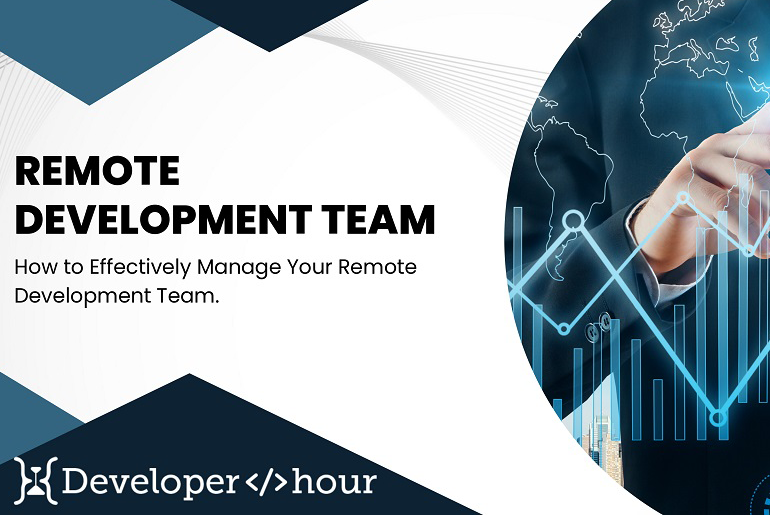Perhaps the most significant legacy of the COVID-19 pandemic is the global rise of remote work. Due to movement restrictions imposed to limit the spread of the virus, individuals were cut off from the rest of the world in 2020, forcing the business world to accelerate its increasing adoption of offshore development teams. Indeed, due to COVID-19, some large global corporations that began with physical work have implemented permanent (or at least long-term) remote work policies, including Twitter, Google, Microsoft, Facebook, and others. Companies started train managers with best practices for managing offshore resources and development teams.
Businesses and entrepreneurs in G7 countries and elsewhere hire offshore resources to develop software offshore. However, other countries are now following suit. However, before you select an offshore development team, you must understand how to work with offshore teams. The best practices for managing offshore resources and development teams must be followed to be effective and productive.
- Best Practices for Managing Offshore Resources and Development Teams
- It starts with the Onboarding Process:
- 1. Establish Better Communication with Tools:
- 2. Use Best Remote Project Management Tools:
- 3. Work on Time Zone Grab Advantage:
- 4. Schedule Everything:
- 5. Utilize Time Tracking Tools for Offshore Resources:
- 6. Hire Self-Motivated and Organised Offshore Developers:
- 7. Improve communication within the team:
- 8. Keep Policies Transparent:
- 9. Build Processes (Development, Reporting, Delivery, Software Over Docs):
- 10. Provide Constant Feedback:
- 11. Lift Team Spirit – We Vs Them:
- 12. Risk Assessment and Backup:
- 13. Reward Your Offshore Development team & Programmers:
- 14. Involved in team-building activities:
- Conclusion:
- Frequently Asked Questions:
Best Practices for Managing Offshore Resources and Development Teams
The biggest challenge for managers in the world of remote work culture is accepting the fact that developers will not be visible. Managers must now find ways to manage and monitor work remotely. Managers also need to learn how to work with offshore teams. This new paradigm has required developers to change their practices and integrate various mechanisms to manage and track offshore teams’ progress. These Best Practices for Managing Offshore Development Teams allow managers and developers to be more productive.
Remote work is a cost-cutting strategy that increases worker productivity when adequately managed. However, it is not so simple to put into action. However, the main issue for many businesses is not adopting remote work; instead, it is how to manage the team to deliver successful results. After all, most companies are unfamiliar with remote work. Furthermore, managing technical projects like software development remotely appears to be complicated. Let’s learn how to work with offshore teams and best practices for managing offshore resources.
It starts with the Onboarding Process:
Many businesses have successfully managed offshore development teams that have produced amazing projects. Some of the most successful startups have massive offshore teams, with their entire workforce working remotely. It only makes sense to be inspired by some examples and learn best practices for managing offshore resources despite obvious physical constraints.
Managing a development team from anywhere is difficult, but managing an offshore software development team is even more difficult. To make it more efficient, a few basic steps must be taken, as mentioned below –
- Establish Better Communication with offshore Team.
- Use the Best Project Management Tools.
- Work on Time Zone Grab Advantage.
- Schedule Everything.
- Utilize Team Time Tracking Tools.
- Hire Self Motivated and Organised Developers.
- Improve communication within the team.
- Keep Policies Transparent.
- Build Processes (Development, Reporting, Delivery, Software Over Docs).
- Provide Content Feedback.
- Lift Team Spirit – We Vs Them.
- Risk Assessment and Backup.
- Reward Your Offshore Development team & Programmers.
- Involved in team-building activities.
1. Establish Better Communication with Tools:
Whether we’re talking about an in-house or remote offshore development team, establishing a strong rapport with each team member is the most important thing. You must communicate clearly with them and ensure that your in-house and offshore teams are on the same page.
It is critical to ensure proper communication when managing an offshore team. Setting meetings and working with people in different time zones can be difficult. However, with effective communication, you can face these challenges wisely. Maintain a strict schedule and an organized workflow, and ensure that everyone on your team is on the same page. Make stand-up meetings a priority, and keep them regular, relevant, and brief. Also, hold many face-to-face meetings to give this highly technical setup a human touch.
2. Use Best Remote Project Management Tools:
Communication tools are one of the best practices for managing offshore resources because they help you structure your team’s work. An effective remote offshore development team will have tools, including email, file sharing, an instant messaging platform, project management software, video conferencing, and whatever else is needed. For example –
- Trello: This simple and free project management software for managing offshore teams. Trello allows you to make different boards for different projects and manage tasks with lists and cards.
- GitHub: GitHub is a tool used by over 50 million developers worldwide. This free code hosting platform is useful for team collaboration and version control.
- Slack: It is an excellent platform for creating various channels and dedicated spaces for teams to collaborate and communicate. Slack also allows you to communicate with a specific developer rather than the entire team through direct messages and other private channels.
- Zoom: This popular video-conferencing app can be used for team collaboration.
3. Work on Time Zone Grab Advantage:
One possible solution to this problem is to use the “golden hours,” which are the hours when your time zones overlap and both you and your team are available. You only need the time zones for you and your team to calculate them. For example, if you are in London (UTC) and your team is in Ukraine (UTC+2), you will be in sync. There is a 2-hour difference, but if you and they both start work at 9 AM and work 8-hour days, you have five hours per day to interact — 9 AM-2 PM for you and 1 PM-5 PM for them. As long as all meetings and discussions are moved to those times, the problem is solved — instant communication is available.
Maintaining a shared calendar is an aspect of dealing with time zone differences. Google Calendar, World Clock Meeting Planner, and Timezone.io can all help with this.
4. Schedule Everything:
Schedule daily stand-up meetings, weekly progress reports, and monthly “all-hands-on-deck” demos for the entire team if you have “golden hours.” This allows you to keep your finger on the pulse and resolve any roadblocks or bottlenecks that arise. These meetings are also beneficial for sharing ideas and accomplishments and staying accountable and aligned with one another.
Your offshore development team members will be working in a different time zone and from a different location. Maintaining strict attendance at scheduled meetings will help you organize your day and your team’s workflow. Meetings that are not held on time can lead to communication breakdowns, delaying the launch of your project.
Meetings, pair programming, scrum, and Q&A sessions should all be scheduled for a few hours daily for maximum productivity. Aside from that, give the developers control over their working hours.
5. Utilize Time Tracking Tools for Offshore Resources:
While you can have each member install a timer on their computer and report the tasks and time spent daily, this is a very inefficient way to use their time. Consider using dedicated time-tracking tools for development teams instead. Time-tracking tools are one of the crucial aspects when it comes to best practices for managing offshore resources and development teams.
- Jira – It is a software development industry standard. Jira may appear intimidating at first glance, but actual developers will frequently require only the Kanban board functionality — which is fairly intuitive and simple. Furthermore, it integrates well with the Atlassian infrastructure and strongly synergizes with Slack.
- Asana – Asana is a friendlier competitor to Jira. It almost has the same features as the iPhone but has a much better user experience and less clutter. It’s also less expensive, with a trial version available for teams of less than 15 persons.
6. Hire Self-Motivated and Organised Offshore Developers:
Determine whether your potential employees are motivated — and what motivates them. Ask specific behavioral questions to understand how the team members approach remote work. Read the reviews and feedback from your employees’ previous clients on Clutch to prepare for interviews.
Trust your team once you’ve made your decision and hired them. There is still mistrust of offshore teams, and you may waste brainpower on constant worries rather than your primary focus. Finally, remember that experience is the most valuable asset you can have.
Related Post: Guide: How to Hire A Remote Software Developer?
7. Improve communication within the team:
This is possibly the most critical aspect of managing offshore teams. Communication is essential for successful remote development (or work in general).
The most critical issue for managing offshore teams is communication. Meetings and working with people from different time zones are difficult to schedule. Ensure you have a strict schedule and an organized workflow and that your team is up to date on everything. We stress the significance of stand-up meetings. They should be brief, pertinent, and consistent.
You need a mix of synchronous and asynchronous communication to keep the project running. When all parties are present and active, synchronous communication is defined as live messaging or video conferencing. Asynchronous messaging is used when messages are sent infrequently, and a response is not required immediately.
8. Keep Policies Transparent:
It’s easy to lose track of people you don’t see daily at work. However, you must keep the offshore team and resources updated on what is happening in the company. Everyone should be aware of the company’s goals, critical decisions, changes in strategy, and other important information. Make sure to document everything and send it to everyone on your team, whether they are on-site or not. Transparency lets your offshore team of developers understand what success means for your company and what they need to do to get there.
9. Build Processes (Development, Reporting, Delivery, Software Over Docs):
It’s highly unlikely that putting random people from all over the world in a virtual environment will result in them producing outstanding work immediately. Processes are required to make it happen. A methodical approach to managing a remote team is essential for your project.
The Agile Manifesto’s core principles can unquestionably be applied to distributed teams. For example,
- software trumps documentation.
- Responding to change trumps sticking to a plan.
- Quality interactions trump tools.
To foster Agile development methodology with your remote development teams, use continuous integration, encourage knowledge sharing, and prioritize communication.
10. Provide Constant Feedback:
The speed and thoroughness with which you provide feedback determine the outcomes of each iteration and sprint. Discuss which tool you will use with your project manager so that you can keep everyone up to date on your decisions and tasks.
Providing timely feedback to offshore development team and reseources is critical as the product is being developed, especially in the case of software, where a minor bug or error can make all the difference. As a result, for each iteration and sprint, provide detailed feedback.
11. Lift Team Spirit – We Vs Them:
Being a member of a team you’ve never met before is very different from having colleagues you see every day. It can be difficult to form bonds with an offshore team of developers, but avoid developing a “we” vs. “them” mentality. Treat them as if they are a member of your team who just happens to work from a distance.
Here are some pitfalls to avoid when working with both offshore and an in-house team:
- Treat the offshore development team the same as the in-house team, including using the words “them” and “us.”
- Ensure the offshore team of programmers is represented in all meetings, work, and other activities.
- Facetime regularly and make an effort to connect with team members.
In addition, take a brief business trip to meet the IT professionals you’ve hired in person. This is an excellent start to your project. While on-site, you can hold a few sessions to resolve any outstanding issues with your project. In this case, neither you nor your team members will be pressed for time, and everyone will be committed to communicating in the same meeting room.
12. Risk Assessment and Backup:
Before beginning the project, a comprehensive assessment must be performed to identify risk factors in knowledge management, task assignment, geographical flexibility, cultural differences, technology/infrastructure setup, and so on. Similarly, a backup plan should be in place to keep the work on track if things get out of hand.
Some of the difficulties that may arise include:
- Time constraints: projects frequently go over budget. One solution is to have a strong discovery phase. Filling in every detail at this stage has aided ProCoders’ offshore development teams.
- Lack of funds is another factor that could cause the budget to fail. To cut costs, hire offshore developers from countries like Ukraine, where wages are lower but the quality is high.
- Unreliability: Certain hiring models for an offshore development team are riskier than others.
However, you must have faith in the team. Managing offshore team of programmers entails having faith in them. When you hire an offshore development company, treat their employees as individuals who can make your idea a reality rather than as property. Encourage and treat them as team members. They already value your project as much as you do. If you don’t study what’s been done and provide constructive feedback, you risk wasting more time redoing things because you didn’t pay attention earlier. Listen to your developers and designers if you don’t have a technical background to understand the functionality better.
At the start of your project, you should have a proper plan and backup solutions in case something goes wrong. In terms of making the situation go away, a backup plan does not always work. However, it must, at the very least, mitigate the consequences of the situation. In software development, adaptability is a critical success factor.
13. Reward Your Offshore Development team & Programmers:
You are your team leader, and your employees will seek approval. In team management, giving tasks is one thing, but praising for work done is another. Praise will undoubtedly improve your team’s performance. You can begin each meeting on a high note by praising the work done thus far.
Give them cash bonuses for going above and beyond their duties, such as staying late to solve a critical problem regularly. It may appear to the most pragmatic managers to be an unnecessary waste of time. However, having a positive team culture often leads to faster and more effective development.
14. Involved in team-building activities:
To build a proper team, you must do activities like casual chit-chat at the beginning of a conference call, play icebreaker games, etc.
Conclusion:
You’re in for a rude awakening if you’ve always worked in the same building as your colleagues. However, you will reap enormous benefits if you learn to manage offshore development teams. Great developers work in teams worldwide, and their geographical location never determines the quality of their work.
Working with an offshore development team may be more complex than working with an in-house team. You can accelerate development progress by focusing on critical areas such as adhering to work procedures established with the team, scheduling properly, and demonstrating enthusiasm. Your company benefits from offshore resources and on-site developers. You can successfully manage an offshore development team by recognizing and appreciating their contributions.





